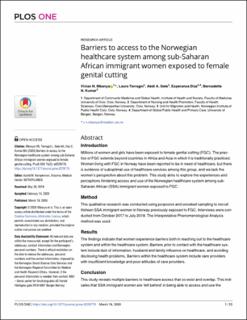| dc.contributor.author | Mbanya, Vivian N. | |
| dc.contributor.author | Terragni, Laura | |
| dc.contributor.author | Gele, Abdi | |
| dc.contributor.author | Diaz, Esperanza | |
| dc.contributor.author | Kumar, Bernadette. N | |
| dc.date.accessioned | 2021-05-03T10:19:34Z | |
| dc.date.available | 2021-05-03T10:19:34Z | |
| dc.date.created | 2020-05-28T16:50:07Z | |
| dc.date.issued | 2020-03-18 | |
| dc.Published | PLOS ONE. 2020, 15 (3), 1-22. | |
| dc.identifier.issn | 1932-6203 | |
| dc.identifier.uri | https://hdl.handle.net/11250/2753207 | |
| dc.description.abstract | Introduction
Millions of women and girls have been exposed to female genital cutting (FGC). The practice of FGC extends beyond countries in Africa and Asia in which it is traditionally practiced. Women living with FGC in Norway have been reported to be in need of healthcare, but there is evidence of suboptimal use of healthcare services among this group, and we lack the women’s perspective about this problem. This study aims to explore the experiences and perceptions hindering access and use of the Norwegian healthcare system among sub- Saharan African (SSA) immigrant women exposed to FGC.
Method
This qualitative research was conducted using purposive and snowball sampling to recruit thirteen SSA immigrant women in Norway previously exposed to FGC. Interviews were conducted from October 2017 to July 2018. The Interpretative Phenomenological Analysis method was used.
Results
The findings indicate that women experience barriers both in reaching out to the healthcare system and within the healthcare system. Barriers prior to contact with the healthcare system include lack of information, husband and family influence on healthcare, and avoiding disclosing health problems. Barriers within the healthcare system include care providers with insufficient knowledge and poor attitudes of care providers.
Conclusion
This study reveals multiple barriers to healthcare access that co-exist and overlap. This indicates that SSA immigrant women are ‘left behind’ in being able to access and use the Norwegian healthcare system. Therefore, appropriate interventions to improve access to healthcare should be considered in order to reach Universal Health Coverage, thus having a positive impact on the health of these women. Equitable healthcare should be reflected in policy and practice. | en_US |
| dc.language.iso | eng | en_US |
| dc.publisher | Public Library of Science | en_US |
| dc.rights | Navngivelse 4.0 Internasjonal | * |
| dc.rights.uri | http://creativecommons.org/licenses/by/4.0/deed.no | * |
| dc.title | Barriers to access to the Norwegian healthcare system among sub-Saharan African immigrant women exposed to female genital cutting | en_US |
| dc.type | Journal article | en_US |
| dc.type | Peer reviewed | en_US |
| dc.description.version | publishedVersion | en_US |
| dc.rights.holder | Copyright 2020 Mbanya et al. | en_US |
| dc.source.articlenumber | e0229770 | en_US |
| cristin.ispublished | true | |
| cristin.fulltext | original | |
| cristin.qualitycode | 1 | |
| dc.identifier.doi | 10.1371/journal.pone.0229770 | |
| dc.identifier.cristin | 1813098 | |
| dc.source.journal | PLOS ONE | en_US |
| dc.source.40 | 15 | |
| dc.source.14 | 3 | |
| dc.source.pagenumber | 1-22 | en_US |
| dc.identifier.citation | PLOS ONE. 2020, 15(3), e0229770 | en_US |
| dc.source.volume | 15 | en_US |
| dc.source.issue | 3 | en_US |

